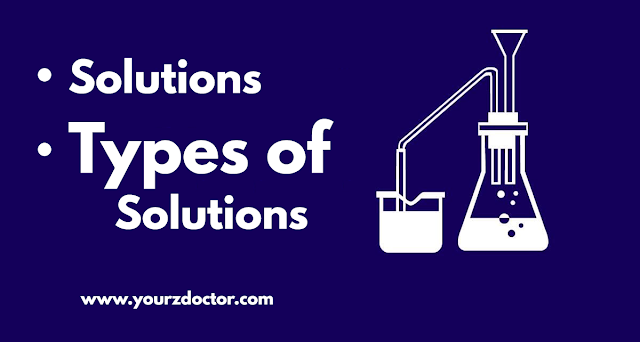Solutions: What They Are and Different Types Explained
In the field
of chemistry, a solution
is a mixture of two or more substances that are evenly distributed in a single
phase. This means that when a solution is formed, the substances that make it
up become completely mixed together and cannot be easily separated. In this
article, we'll explore the different types
of solutions and their properties, as well as delve into some real-world
applications.
What is a Solution?
A solution
is a type of mixture that consists of two or more substances that are evenly
distributed in a single phase. This can refer to liquids, gases, or solids. The
key characteristic of a solution is that the substances that make it up are
evenly mixed, meaning that they cannot be easily separated from one another.
The
substances that make up a solution are called the solute and the solvent. The
solute is the substance that is dissolved in the solvent, and the solvent is
the substance in which the solute is dissolved. In other words, the solvent is
the substance that is present in the greatest amount in the solution.
Properties of Solutions
Solutions
have a number of properties that set them apart from other types of mixtures.
Some of the key properties of solutions include:
· Homogeneity:
Solutions are homogeneous, meaning that they are evenly mixed and have the same
composition throughout.
· Solute
concentration: The concentration of the solute in a solution can be measured
and is often expressed in terms of the number of moles of solute per liter of
solvent.
· Solubility: The
solubility of a solute in a solvent refers to the amount of solute that can
dissolve in the solvent to form a solution.
· Saturated vs.
Unsaturated: If a solution contains the maximum amount of solute that can be
dissolved in a given amount of solvent, it is called a saturated solution. If
it contains less than the maximum amount, it is called an unsaturated solution.
Types of solutions
There are
several different types
of solutions, each with its own unique properties. Some of the most
common types of solutions include:
Aqueous Solutions
An aqueous
solution is a solution in which water is the solvent. This type of solution is
common in chemistry, as water is an excellent solvent for many different types
of solutes, including salts, acids, and bases.
Gaseous Solutions
Gaseous
solutions, also known as gas mixtures, are mixtures of gases that are evenly
distributed in a single phase. This type of solution is often used in
industrial processes, such as the production of fuels and other chemicals.
Solid Solutions
Solid
solutions are mixtures of solid substances that are evenly distributed
throughout. This type of solution is often used in the production of alloys,
which are mixtures of metals that have different properties than the metals
would have on their own.
Real-World Applications of Solutions
Solutions
play a critical role in many areas of our lives, and they are used in a wide
range of industries and applications. Some of the most common real-world
applications of solutions include:
Medicine
Solutions
are widely used in the medical field, from simple saltwater solutions used for
irrigation to complex drug solutions used to treat a variety of conditions.
Food and Beverage
Solutions
are also important in the food and beverage industry, as they are used in the
production of many common products, such as soft drinks and juices.
Industrial Production
Solutions
play a critical role in many industrial processes, including the production of
fuels, chemicals, and other products. For example, many industrial processes
rely on solutions to transport, mix, or react with other substances. In the
production of chemicals, solutions are used to dissolve, mix, or separate
different substances to create the desired product.
Environmental Science
Solutions
are also used in the field of environmental science, where they are employed in
a variety of applications, such as water treatment and air purification. In
water treatment, solutions are used to remove contaminants and impurities,
making the water safe for consumption. In air purification, solutions are used
to remove pollutants and harmful substances from the air.
Conclusion
In
conclusion, solutions play a crucial role in many areas of our lives, from
medicine to industrial production. Understanding the different types of solutions and their properties
is essential for those working in the field of chemistry, as well as for anyone
interested in learning more about the world around them. Whether you are a
student, scientist, or simply someone who is curious about how things work,
understanding solutions can help you gain a deeper appreciation for the
complexity and beauty of the natural world.
Learn More about relevant post
Related Tags,
solutions,types of solutions,types of solutions chemistry,solution,3 types of solutions,types of solid solutions,solutions chemistry
class 12,solutions and types of solutions
class 9 chemistry,solutions chemistry,class 12 chemistry solutions,isotonic
solutions,unsaturated solution,six types
of solutions,supersaturated solution,saturated solution,types of solution,types of solutions lecture,solutions
class 12,types of buffer solutions






0 Comments